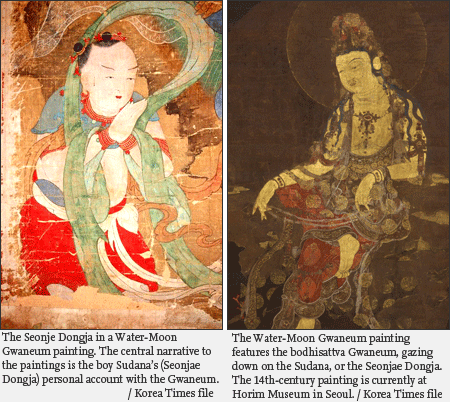
Buddhist paintings, known in Korea as “taenghwa,” of the Goryeo Kingdom (918-1392) are especially celebrated for their artistic excellence. In tandem with religious prosperity, the period of Goryeo produced lavishly detailed paintings of Buddhist deities, exhibiting refined tastes of the era.
Particularly celebrated among them are “Water-Moon Gwaneum” paintings which mean “Avalokitesvara bodhisattva gazing at the moon in the water painting”. Gwaneum, Avalokitesvara, is considered to be the embodiment of the Buddhist virtue of compassion who “Observes the Sounds of the World.”
In the outset, the Water-Moon Gwaneum painting acquired its appellation as the serene and graceful image of the bodhisattva Gwaneum, compared to the reflection of the moon on water.
The earliest references for the association of water and the moon to Gwaneum are found in eighth century Chinese records, and by the Song dynasty (960-1279), and this distinctive iconic image became widespread.
In Korea, the “Water-Moon” type of Gwaneum paintings existed at least by the 11th century, and during the Goryeo period, its iconography and style further developed, achieving an extraordinary artistic refinement.
Subsequently, the “Water-Moon” representation became one of the most frequently depicted images of Gwaneum and the practice continued into the Joseon Kingdom (1392-1910).
Today about 160 Goryeo Buddhist paintings are known to us, most of them preserved in Japan. Of those, around 40 are of the Water-Moon Gwaneum and constitute the largest number of portrayals of a single devotional deity.
Among the most representative of the Goryeo Water-Moon Gwaneum paintings, some of the widely known dated works include the painting in Kagami-jinja (1310) and the one painted by Seo Gubang in Senoku Hakokan (1323), Japan. Other works in the Musee Guimet, France and the Hoam Art Museum, Korea are also of note.
The central narrative of the Goryeo Water-Moon Gwaneum paintings is the boy Sudana’s (Seonjae Dongja) personal encounter with the bodhisattva Gwaneum. This momentous event takes place at Mount Potalaka (Naksan in Korean), a supernatural realm in the midst of the sea where this popular Buddhist deity, Gwaneum, is known to reside.
The “Entering the Dharma Realm” (Gandhavyuha) chapter of the Avatamsaka Sutra (Flower Garland Sutra) details the journey of Sudana, who undertakes a pilgrimage to visit 53 masters in his quest of enlightenment; on his 28th visit, Sudana meets Gwaneum and receives instructions.
Based on this scriptural source, the Goryeo painters have dramatized the scene with exceptional dexterity.
In paintings, Water-Moon Gwaneum is elegantly portrayed exuding a sense of presence in the midst of tranquility. He is seated on a rocky outcrop, his body slightly turned to the side, in the “posture of royal ease,” having one leg crossed and the other foot gently resting on a lotus flower support. In the water surrounding him are the varying rocky formations from which precious corals are grown.
At the bottom corner of the painting, the tiny figure that the bodhisattva gazes down on is Sudana. The boy attentively looks up at the Water-Moon Gwaneum as he joins his palms together in a gesture of obeisance.
The rendering of Water-Moon Gwaneum’s attire especially demonstrates the outstanding standard of the Goryeo painters. The layers of robes and transparent sashes gracefully cascade down the contour of the body, and, along with the dazzling jewelry, the patterns and the lines of the drapery are illuminated with gold.
Such displays of garments’ fluidity and radiance, in effect, generates a mystical ambience. And the mood further extends by the auras encircling the head and the shimmering body of the bodhisattva.
The Goryeo paintings of the Water-Moon Gwaneum also include a common set of attributes. The bodhisattva wears a crown with an image of the incarnation of Amitabha Buddha and in his hand holds a crystal rosary.
In the background are the upright bamboos and the healing willow branch placed in a “kundika” bottle, of which stands on a clear glass bowl.
Sometimes, additional iconographical features appear occupying the space where Sudana is normally positioned. One bottom corner of the paintings in Datoku-ji and the Metropolitan Museum of Art depicts the dragon king leading a group of figures and the sea monsters following behind them.
Accordingly the boy Sudana is repositioned at the opposite end of the painting.
Another variant, which draws one’s attention, are the illustrations at the very bottom of the painting in Danjan-jinja. Incised in gold, it sketches an array of predicaments in which a person may be situated, such as being chased by a snake or a tiger, robbed by bandits, being bedridden or trapped in a burning house.
These accounts suggestively emphasize the compassionate and benevolent nature of Gwaneum expounded in chapter 25 (“The Universal Gate of the Bodhisattva Perceiver of the World’s Sounds”) of the Lotus Sutra, the scripture fundamental to the faith of Gwaneum.
When people are confronted with trials or have wishes, upon single-mindedly calling the name of the bodhisattva Gwaneum, he would hear those voices and attend to them by manifesting himself in various appearances; the compassionate bodhisattva promises to deliver salvation to all those who seek it.
Beyond the imposing image of the bodhisattva, the humble aspirations of the Goryeo people for salvation are deeply imbued in the paintings of the Water-Moon Gwaneum.
Author : Taylor Pak
Source : http://www.koreatimes.co.kr/www/news/art/2010/05/135_66201.html




